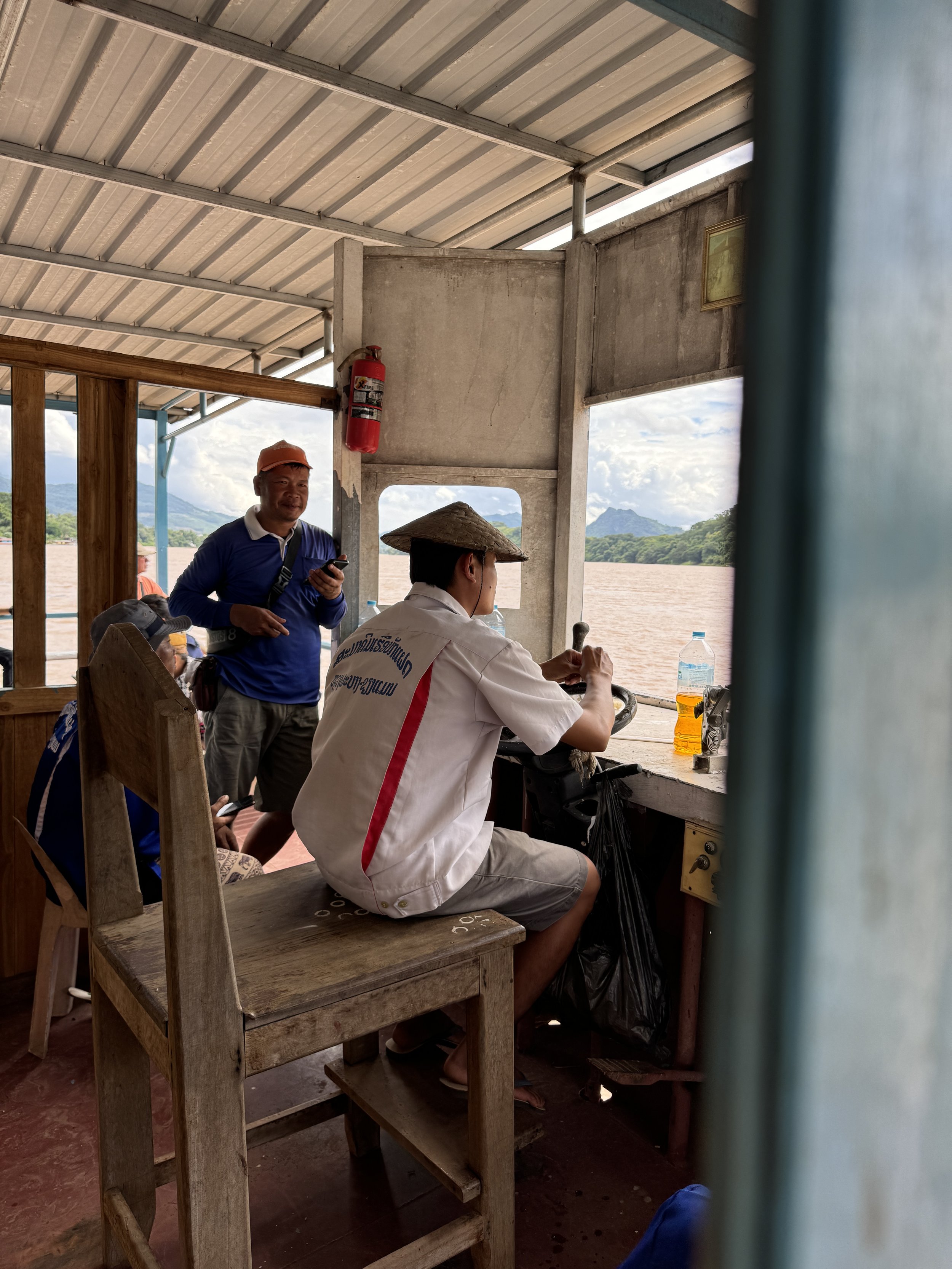Luang Prabang
Posted July 25
Traveling from Vang Vieng to Luang Prabang is now much easier thanks to the high-speed train. A journey that used to take 5-6 hours by bus, especially in the wet season when roads would notoriously get washed out, now is done in an hour.
The railway station in Vang Vieng is pretty close to the town center, but in Luang Prabang, like Vientiane, it’s pretty far away. A private car/taxi costs about $10 to the center of town, which isn’t that different from the $12 that the train ticket from Vang Vieng costs.
Getting off the high-speed train in Luang Prabang
Luang Prabang is another stunning visual experience. Like Pakse, it’s situated at the confluence of the Mekong and a smaller tributary. In this case, it’s the Nam Khan river. In Pakse, the valley is very wide and the Bolaven Plateau is visible in the distance. Quite different, the valley in which Luang Prabang is situated is narrow, and the hills surrounding the valley are abutted right next to the town. It yields yet another of Laos’ innumerable visual treats.
The historic district of Luang Prabang is on a peninsula that juts out into the Mekong. It was designated a UNESCO World Heritage Site in 1995 for its preservation of religion, culture and architecture, and indeed those preserved features are in abundance here. Even the commercial district of the peninsula is made up of restored colonial era buildings. You can imagine the French eating baguettes and planning their next victory.
Looking East from Phou Si Hill in Luang Prabang
From the early morning (5:30AM!!) Alms Ceremony to the numerous temples that are on almost every street corner, it is a quiet, meditative area. Even with the tourists throughout town, it is quiet and serene.
That serenity is enhanced by the fact that most of the historic district is off-limits to cars, so you can walk freely and admire the historic architecture without trouble. Although there are a few scooters that go through those neighborhoods, usually by locals who live in the neighborhoods, for the most part the small alleys and lanes are motor-free.
The historic district is approximately 500 meters wide by 1.5km long. The scale makes it ideal to explore on foot, and that in turn slows down the discovery so that small details that might usually go unnoticed become the center of attention.
Typical lane in the historic district
The Mekong River is a big part of life here. There are ferries and longboats going up, down, and across the river. There’s a famous two-day trip by longboat that starts in the north by the Thai border and ends here in Luang Prabang. Eschewing that particular path, I did take the ferry on the quick trip across the Mekong to the small village that’s across the way.
The ferry has its own way of operating that probably doesn’t meet any western safety standards, but it seems to make it across every 10-15 minutes with cars, trucks, scooters, and people. The steering wheel of the ferry being taken from a Toyota car of unknown origin also adds to the feeling of security. Toyota makes good steering wheels.
The scenery crossing the Mekong is, as expected, wonderful, and lets you temporarily forget how rickety the ferry is.
The captain of the Ferry navigating us safely across the Mekong
Outside of town there are a couple of typical visits. Kuang Si waterfalls are a series of waterfalls in the hills about 20km out of town. There’s one main waterfall that is about 200 feet tall, and then a series of smaller ones as the river makes its way to the Mekong.
The lower falls all have small pools that are excellent for swimming, and on a muggy and hot day, that’s just what I did. The road to the Falls is pretty rugged in places, despite being part of what used to be the major highway between Vientiane, Vang Vieng, and Luang Prabang. I was told that the road washes away on a regular basis and gets rebuilt a little bit shoddier each time.
Pak Ou caves are outside town the other direction and is a temple built into a large cave. One particular cave is called the Cave of 1000 Buddhas for all the statues it contains.
Some of the lower pools of Kuang Si Falls are great for swimming
And, of course there’s a morning market. It’s actually on the street that my Hotel is situated on, so it is very easy to visit for me. There’s every type of ingredient you’d ever need for your meals, and I see staff from the restaurants on the main road coming to buy ingredients for their dishes.
Lots of exotic items are for sale. I’ve seen snakes, eels, turtles, ducks, and insect larvae. There’s more mundane items as well like mint, onions, fruit, and typical staples.
The night market is also on the street next to my hotel, so I’ve been able to see the activity each night. Overall, it is a typical night market, but maybe a little more focused on Lao handicrafts. The hand dyed/printed fabric items are particularly common, and seem to be very low priced. A typical hand woven tablecloth sells for under $2.
So far, Luang Prabang has been a quiet, peaceful, and beautiful stop,
Insect Larvae and Honeycomb with Larvae for sale at the morning market





